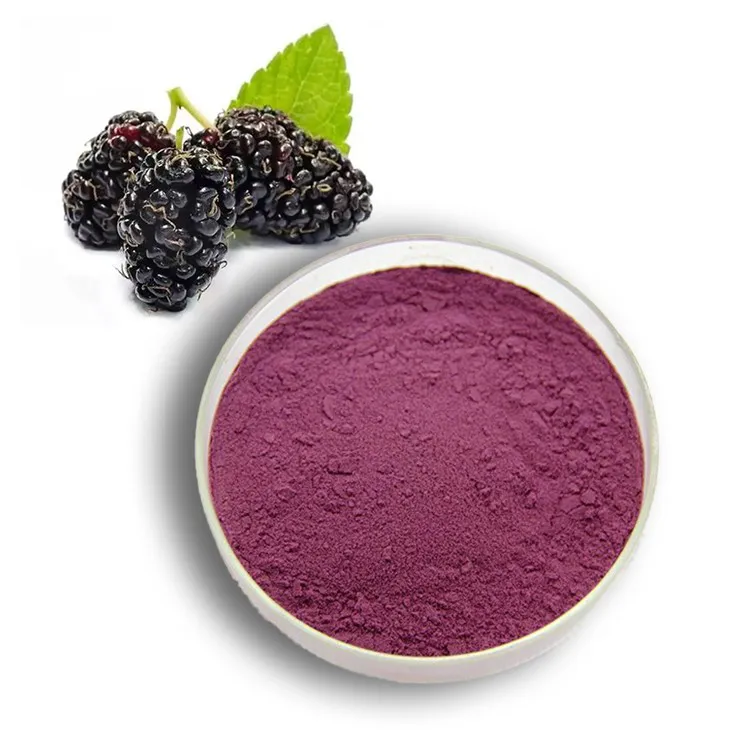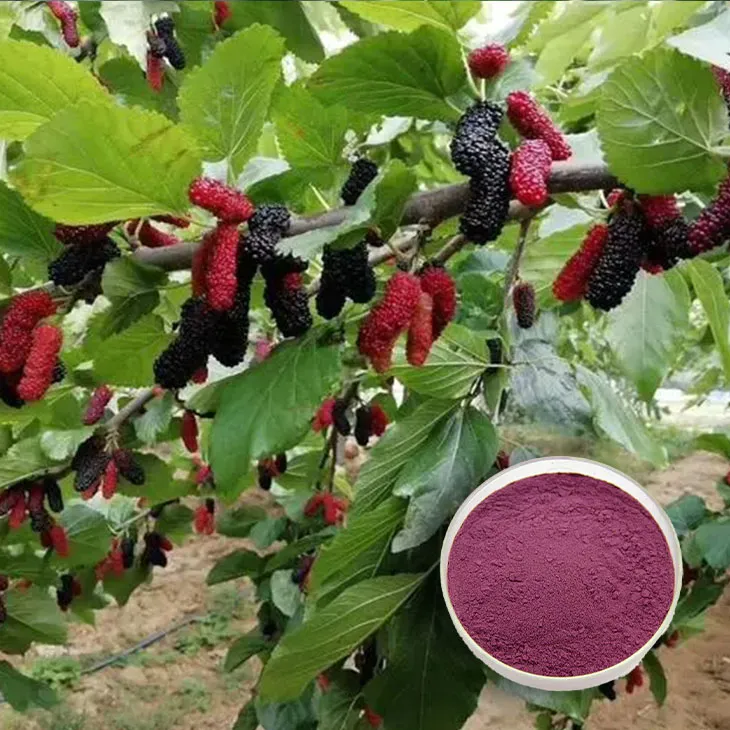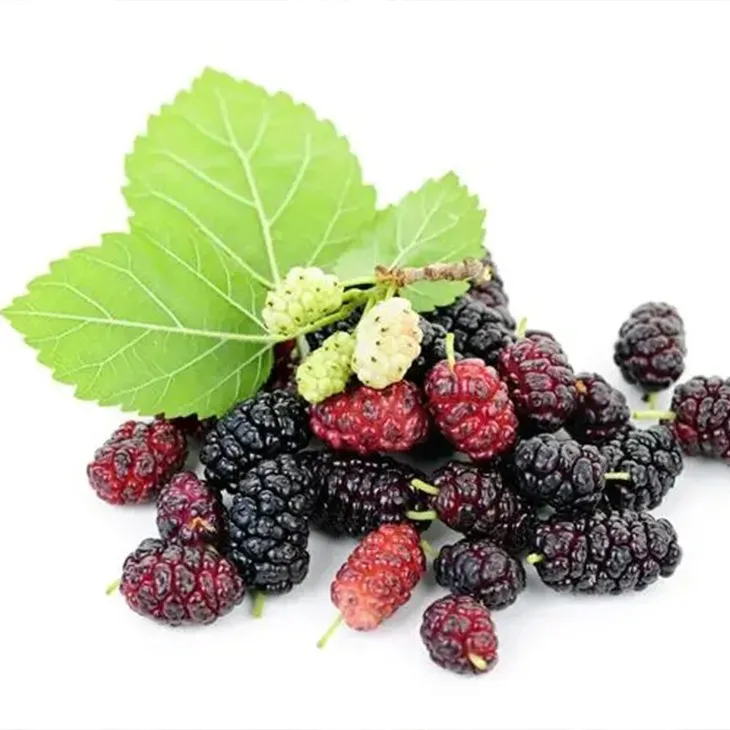- 0086-571-85302990
- sales@greenskybio.com
The Optimal Method for Extracting Mulberry Extracts.
2024-11-30

1. Introduction
Mulberries are rich in various bioactive compounds, such as anthocyanins, flavonoids, and phenolic acids. These components endow Mulberry Extract with a wide range of potential applications, including in the food, pharmaceutical, and cosmetic industries. Therefore, extracting high - quality Mulberry Extract is of great significance. However, the extraction process is influenced by multiple factors, and different extraction techniques have their own characteristics. This article will explore the best method for extracting Mulberry Extract by discussing various factors and comparing traditional and modern extraction techniques.

2. Factors Influencing Mulberry Extract Extraction
2.1. Raw Material Quality
The quality of mulberry raw materials is a crucial factor. Freshness, maturity, and variety of mulberries can significantly affect the extraction results. For example, fully ripe mulberries usually contain higher levels of bioactive compounds compared to unripe ones. Different mulberry varieties may also have different compositions of active ingredients.
2.2. Solvent Selection
The choice of solvent is fundamental in the extraction process.
- Water: It is a commonly used solvent. Water extraction is relatively simple and environmentally friendly. However, it may have a limited ability to extract some hydrophobic components.
- Ethanol: Ethanol - based solvents are often preferred. Ethanol can extract a wide range of bioactive compounds effectively. Different ethanol concentrations (e.g., 50%, 70%) can be used depending on the target compounds. Higher ethanol concentrations are generally more suitable for extracting hydrophobic substances.
- Other Solvents: Some other solvents like methanol or acetone can also be used in certain cases. But they may have some disadvantages such as toxicity, which restricts their application in the food and pharmaceutical industries.
2.3. Extraction Temperature
Temperature plays an important role in extraction.
- At a relatively low temperature, the extraction rate may be slow. For example, when water extraction is carried out at room temperature, it may take a long time to obtain a sufficient amount of extract.
- However, increasing the temperature too much can lead to the degradation of some bioactive compounds. For instance, anthocyanins are sensitive to high temperatures, and excessive heat can cause their decomposition, reducing the quality of the extract.
2.4. Extraction Time
The extraction time also affects the extraction efficiency and quality.
- A short extraction time may result in incomplete extraction of bioactive compounds. For example, if the extraction time is only a few minutes, only a small portion of the target compounds may be extracted from the mulberry.
- On the other hand, an overly long extraction time may not necessarily increase the extraction yield further. Moreover, it may introduce more impurities or cause the degradation of some compounds.
2.5. Particle Size of Raw Materials
The particle size of mulberry raw materials affects the contact area between the raw materials and the solvent.
- Smaller particle sizes can increase the contact area, which generally promotes the extraction process. For example, if the mulberries are ground into fine powder, the solvent can more easily penetrate into the material and extract the bioactive compounds.
- However, if the particle size is too small, it may also lead to some problems such as clogging during the extraction process or increased impurity extraction.

3. Traditional Extraction Techniques
3.1. Maceration
Maceration is one of the simplest traditional extraction methods.
- The mulberry raw materials are soaked in a solvent (usually ethanol or water) in a closed container.
- The mixture is left to stand for a certain period, which can range from several hours to days. During this time, the solvent gradually penetrates the mulberry tissues and extracts the bioactive compounds.
- After the maceration period, the extract is separated from the solid residue by filtration or centrifugation.
- It is a relatively low - cost method and does not require complex equipment.
- It can be easily carried out on a small scale.
- The extraction time is usually long, which may lead to the degradation of some compounds.
- The extraction efficiency is relatively low compared to some modern techniques.
3.2. Soxhlet Extraction
Soxhlet extraction is a more efficient traditional method.
- The mulberry sample is placed in a Soxhlet extractor. The solvent is continuously recycled through the sample in the extractor.
- The extraction process continues until a sufficient amount of extract is obtained. This usually takes several hours.
- Finally, the extract is separated from the solvent through distillation or other methods.
- It can achieve relatively high extraction efficiency compared to maceration.
- It can effectively extract some compounds that are difficult to extract by simple maceration.
- It requires a Soxhlet extractor, which is relatively complex equipment.
- The extraction process may use a large amount of solvent, and the extraction time is still relatively long.
- There is also a risk of thermal degradation of some compounds due to the continuous heating during the extraction process.

4. Modern Extraction Techniques
4.1. Ultrasonic - Assisted Extraction
Ultrasonic - assisted extraction utilizes ultrasonic waves to enhance the extraction process.
- The mulberry raw materials are placed in a solvent in an ultrasonic bath or with an ultrasonic probe.
- The ultrasonic waves create cavitation bubbles in the solvent. When these bubbles collapse, they generate intense local pressure and temperature changes, which help to break the cell walls of the mulberry and release the bioactive compounds more effectively.
- The extraction time is usually shorter compared to traditional methods. After the extraction, the extract is separated from the solid residue.
- It significantly shortens the extraction time. For example, it may only take a few minutes to an hour compared to hours or days in traditional methods.
- It can increase the extraction efficiency, allowing for a higher yield of bioactive compounds.
- It is relatively energy - efficient.
- The equipment for ultrasonic - assisted extraction may be relatively expensive.
- Improper operation may cause over - extraction or damage to some compounds due to the strong ultrasonic effects.
4.2. Microwave - Assisted Extraction
Microwave - assisted extraction uses microwaves to heat the solvent and mulberry mixture.
- The mulberry sample and solvent are placed in a microwave - compatible container.
- The microwaves penetrate the mixture and cause rapid heating due to the interaction with polar molecules in the solvent and the mulberry. This rapid heating promotes the extraction of bioactive compounds by increasing the mass transfer rate.
- After the extraction, the extract is separated from the solid residue.
- It is very fast, usually taking only a few minutes to complete the extraction.
- It can achieve high extraction efficiency and a relatively high yield of bioactive compounds.
- It can save energy compared to some traditional extraction methods.
- The equipment also requires a certain investment.
- There is a risk of over - heating and degradation of some compounds if the microwave power and extraction time are not properly controlled.
4.3. Supercritical Fluid Extraction
Supercritical fluid extraction uses supercritical fluids, such as supercritical CO₂, as the extraction solvent.
- The supercritical CO₂ is maintained in a supercritical state (above its critical temperature and pressure). It has properties between a gas and a liquid, which gives it excellent solvent properties.
- The mulberry sample is placed in the extraction chamber with supercritical CO₂. The supercritical CO₂ penetrates the mulberry tissues and extracts the bioactive compounds.
- After the extraction, the pressure is reduced, and the supercritical CO₂ returns to the gaseous state, leaving the extract behind.
- It is a clean and environmentally friendly extraction method as CO₂ is non - toxic and can be easily recycled.
- It can achieve high - purity extraction with minimal residue of the solvent in the final product.
- It can selectively extract specific compounds depending on the operating conditions.
- The equipment for supercritical fluid extraction is very expensive, which restricts its widespread application.
- The operation process requires strict control of temperature and pressure conditions.
5. Comparison and Selection of the Best Method
To select the best extraction method for mulberry extract, we need to consider various factors, including cost, extraction efficiency, extraction time, and the quality of the final product.
- If cost is the primary consideration and a relatively simple setup is acceptable, maceration may be a choice. However, it has the drawbacks of long extraction time and relatively low extraction efficiency.
- For small - scale laboratories or when Soxhlet extraction is already available, Soxhlet extraction can be used. But it also has some limitations such as long extraction time and potential for compound degradation.
- For industrial - scale production with a focus on high - efficiency and relatively short extraction time, ultrasonic - assisted extraction or microwave - assisted extraction may be more suitable. They can significantly reduce the extraction time while maintaining a relatively high extraction efficiency. However, they require certain equipment investment.
- If high - purity extract and environmental friendliness are crucial, supercritical fluid extraction is an excellent option. But the high cost of equipment makes it less accessible for many applications.
6. Conclusion
In conclusion, the extraction of mulberry extract is a complex process influenced by multiple factors. Different extraction techniques, from traditional to modern, have their own advantages and disadvantages. The best method should be selected according to the specific needs of different applications. Whether it is for the food, pharmaceutical, or cosmetic industries, ensuring the extraction of high - quality mulberry extract is essential for realizing its potential applications. Future research may focus on further optimizing the existing extraction methods or developing new techniques to meet the growing demand for mulberry extract with high quality and diverse functions.
FAQ:
Question 1: What are the traditional methods for extracting mulberry extracts?
Traditional methods for extracting mulberry extracts include solvent extraction. For example, using ethanol as a solvent. Maceration is a common approach where the mulberry material is soaked in the solvent for a certain period to allow the active components to dissolve. Another traditional method is decoction, which involves boiling the mulberry parts in water to extract the desired substances. However, traditional methods may have some limitations such as relatively low extraction efficiency and longer extraction time.
Question 2: How do modern techniques improve the extraction of mulberry extracts?
Modern techniques offer several improvements. Supercritical fluid extraction (SFE) is one such method. Using supercritical carbon dioxide as the extraction medium, it has the advantage of being highly selective, which means it can target specific compounds in the mulberry extract more precisely. Another modern technique is microwave - assisted extraction (MAE). Microwave energy is used to heat the extraction system, which can significantly reduce the extraction time compared to traditional methods. Additionally, ultrasonic - assisted extraction (UAE) utilizes ultrasonic waves to disrupt the cell walls of the mulberry material, enhancing the release of active components and improving extraction efficiency.
Question 3: What factors need to be considered when choosing an extraction method for mulberry extracts?
Several factors should be considered. The nature of the active components in the mulberry is important. For example, if the target compounds are heat - sensitive, then a method like supercritical fluid extraction or ultrasonic - assisted extraction may be more suitable as they can operate at lower temperatures compared to traditional decoction. The cost of the extraction process is also a factor. Some modern techniques may require expensive equipment, while traditional methods may be more cost - effective but less efficient. The purity and yield of the extract are crucial as well. Different applications may require different levels of purity and yield, so the extraction method should be chosen accordingly.
Question 4: What are the applications of high - quality mulberry extracts?
High - quality mulberry extracts have diverse applications. In the food industry, they can be used as natural colorants or flavor enhancers. For example, the pigments in mulberry extracts can add color to food products. In the pharmaceutical field, they may have potential health - promoting properties. Some components in mulberry extracts are believed to have antioxidant, anti - inflammatory, and anti - diabetic effects. In the cosmetic industry, mulberry extracts can be used in skin - care products due to their potential to improve skin health, such as reducing wrinkles and enhancing skin elasticity.
Question 5: How can the quality of mulberry extracts be ensured during the extraction process?
To ensure the quality of mulberry extracts during extraction, proper control of extraction parameters is essential. For example, in solvent extraction, the ratio of solvent to mulberry material, extraction time, and temperature should be optimized. In modern techniques like supercritical fluid extraction, the pressure and temperature conditions need to be carefully set. Also, the purity of the starting material, i.e., the mulberry, is important. High - quality, fresh mulberries should be used. Additionally, proper purification steps after extraction, such as filtration and chromatography, can help to remove impurities and ensure a high - quality extract.
Related literature
- Optimization of Mulberry Extract Extraction Using Modern Techniques"
- "Traditional and Modern Approaches in Mulberry Extract Production"
- "The Role of Mulberry Extracts in Different Industries: An Overview of Extraction and Applications"
- ▶ Hesperidin
- ▶ citrus bioflavonoids
- ▶ plant extract
- ▶ lycopene
- ▶ Diosmin
- ▶ Grape seed extract
- ▶ Sea buckthorn Juice Powder
- ▶ Beetroot powder
- ▶ Hops Extract
- ▶ Artichoke Extract
- ▶ Reishi mushroom extract
- ▶ Astaxanthin
- ▶ Green Tea Extract
- ▶ Curcumin Extract
- ▶ Horse Chestnut Extract
- ▶ Other Problems
- ▶ Boswellia Serrata Extract
- ▶ Resveratrol Extract
- ▶ Marigold Extract
- ▶ Grape Leaf Extract
- ▶ blog3
- ▶ Aminolevulinic acid
- ▶ Cranberry Extract
-
The best lemon juice powder in nature.
2024-11-30
-
Organic Vitamin K2 Powder Suppliers
2024-11-30
-
Bulk purchase of L - tyrosine.
2024-11-30
-
Vitamin K2 Manufacturers
2024-11-30
-
Eucommia Ulmoides Extract
2024-11-30
-
Scutellaria Extract
2024-11-30
-
Chia Seed Powder
2024-11-30
-
Peppermint Extract Powder
2024-11-30
-
Epimedium extract powder
2024-11-30
-
Bitter Melon Extract
2024-11-30
-
Hawthorn Extract
2024-11-30
-
Andrographis Paniculata Extract Powder
2024-11-30
-
Acai Berry Extract
2024-11-30
-
Cat Claw Extract
2024-11-30























